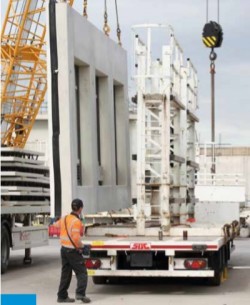The recent news that the Construction Industry Training Board (CITB) is pumping £1.2million into offsite construction teaching materials including those for ‘virtual or immersive environments’ follows its recent report into the ongoing skills crisis and long term implications for the offsite sector.
Using analysis undertaken by Whole Life Consultants, the CITB report ‘The Impact of Modern Methods of Construction on Skills Requirements of Housing’, found that if housebuilding activity were to reach the levels currently being set by the government without any increase in the use of offsite methods, the construction industry would need to boost staff numbers by 195,000 over the next seven years.
Commissioned by the Ministry of Housing, Communities and Local Government (MHCLG) it was set to better understand the contribution that increasing offsite methods in UK homebuilding could make to the workforce needed to deliver them. The study focused on the changes to the workforce profile for both panelised and volumetric homes in relation to those delivered by ‘traditional’ (brick and block). Using the definition and
categorisation of offsite developed by the MHCLG working group on ‘MMC’ assurance, insurance and mortgages, volumetric construction was defined as the production of 3D units in controlled factory conditions which are then assembled together onsite.
Five different offsite scenarios were considered using different percentage bases for construction methods. For example – Scenario 1 – assumed that 50% of homes built in 2025-26 will be based on the mix of types currently being built and the other 50% being built with equal shares of panelised and volumetric types. Current levels of panelised and volumetric construction techniques used in homebuilding are estimated to be at relatively low levels – circa 6%. The five scenarios show that: “ramping up volumes of panelised and volumetric construction to just over 50% of total build might help mitigate some of the longer-term pressure on skilled trade and manual workers.” The analysis highlights that in the short term to 2021: “an increase in the number of homes being built is likely to result in an increased demand for a workforce that supports the existing mix of build types, unless there is a rapid increase in offsite adoption.
”The report picks out a series of challenges for the homebuilding sector including the need to grow and develop skilled trades and manual workers to support an increase in the number of homes built using current construction methods. One key challenge will include upskilling existing workers to cover ‘new’ disciplines such as site management, integration, onsite placement and assembly that are increasingly required for offsite manufacture. This in addition to developing the array of digital skills that are an ever-increasing part of construction work.
While some workforce estimates focus only on the manual and skilled trades that tend to be construction site based, there is an almost equal requirement for non-site-based workers. “Our current estimate of the homebuilding workforce would be 266,000 site-based workers (manual and skilled trades) with nearly 227,000 non-site based, such as office staff, technicians and professionals such as architects and surveyors. The non-manual workforce requirement is consistent across the baseline and offsite scenarios and increasing levels of homebuilding, regardless of construction technique used, is likely to lead to an increased demand for technical, professional and officebased support roles of nearly 90,000 workers by 2025-26.”
The report also outlines a range of recommendations for Government and the CITB in helping the industry respond and embrace the challenges of delivering the levels of homes that are needed – the much quoted – 300,000 per annum – using current construction methods, while also promoting and developing more offsite delivery. Key to progress is collaboration and includes linking into Government action “a forum that promotes and shares information, CITB may have a role in sharing details that form sector insight to support workforce development, by promoting homebuilding as a career within the construction sector by ensuring that there are training standards and qualifications that cover the full range of skills that homebuilding will require in the future and by helping employers to understand and access the range of training opportunities that they will need.”
Likewise, there is also an opportunity for Government to help promote sharing information, such as real data on workforce requirements and best practice information on offsite build techniques, which could help stimulate further industry adoption. This recognises that Government has a “dual role as client for homebuilding, along with an enabler of wider conditions for homebuilding such as planning policies and skills development.”
The scale at which offsite methods need to be adopted is massive and is possibly the main challenge for homebuilding, but as the report picks out, “overall there is potential for increased uptake of offsite to enable more homes to be built and productivity to be improved – the biggest impact would be if significant and rapid progress was made in the adoption of volumetric construction techniques.”









